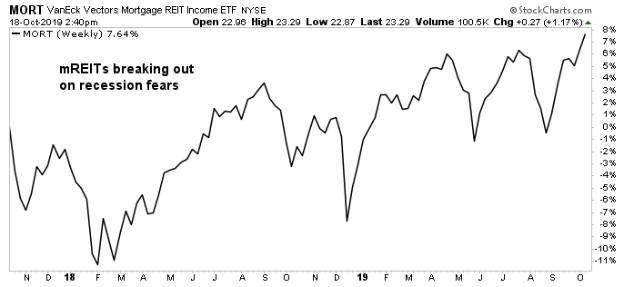One of the World’s Best Income Investments Now Yields 10%

How to Begin Earning a 10% Yield From These Income Investments
Struggling to earn decent yields from income investments? You’re not alone.
Millions of retirees have found themselves on the wrong end of the Federal Reserve’s low interest rate policy. Yes, cheap money has created a windfall for banks, borrowers, and businesses. But for those counting on their nest eggs, those same low rates have wreaked havoc on retirement plans.
For savers, this can spark a lot of anxiety. Will I have enough money to pay for daily expenses? Will I have enough money to pay for unexpected healthcare costs? Will I have enough money to leave something for my grandkids?
Thankfully, there’s a solution.
For the past few years, my colleague Jing Pan has pounded the table on a little-known financial niche called mortgage real estate investment trusts (mREITs). These income investments, which he has nicknamed “alternative banks,” have posted outsized returns for decades. And thanks to a loophole in U.S. tax law, some of these firms pay yields of 10%, 12%, or even 15%.
Here’s what you need to know.
Where to Earn 7% to 13% Yields Outside the Stock Market
Alternative banks are pretty straightforward to wrap your head around.
Like the bank branch down your street, these firms borrow money and lend out the proceeds. They make a profit on the difference, called the spread, between the interest they collect from borrowers and the interest they pay to depositors.
But unlike traditional financial institutions, Alternative banks have no branches, no tellers, and no ATMs. Because they have so little in the way of overhead, almost every dollar on interest income flows straight to the bottom line.
What separates one alternative bank from another is where they invest their capital.
Annaly Capital Management, Inc. (NYSE:NLY), for instance, owns a large portfolio of plain-vanilla home mortgages backed by the U.S. government. Starwood Property Trust, Inc. (NYSE:STWD) earns higher yields by providing financing to commercial real estate developers and landlords.
Other mREITs, such as New Residential Investment Corp (NYSE:NRZ), earn fees from mortgage investors by doing all of the behind-the-scenes paperwork in the mortgage business: handling delinquencies, paying taxes, collecting payments, etc.
In other words, the potential risks and rewards can vary considerably from firm to firm. These partnerships aren’t nearly identical commodity businesses like oil drillers or mining companies.
But most alternative banks do represent lucrative income investments. Mortgage loans, by and large, deliver monthly interest payments. Partnerships can juice the returns on these loans by employing a conservative degree of leverage.
Most importantly, alternative banks pay little to no corporate income taxes to the U.S. government. But in exchange for this privilege, executives must pay out at least 90% of their profits as distributions.
For this reason, it’s not uncommon to see top firms in this industry paying yields in the high single-digits. Those who are willing to take on more risk can collect payments in the mid-teens.
For investors, this has resulted in respectable returns.
Since 1993, the FTSE Nareit U.S. Real Estate Index has delivered a total gain, including dividends, of seven percent annually. If you had invested $100.00 in this industry at the start of that period, your position would be worth $542.00 today. And investors have good reason to expect those returns to keep rolling in.
The Five Largest Alternative Banks
| Company Name | Market Cap | Yield |
| Annaly Capital Management, Inc. | $13.0 Billion | 11.0% |
| AGNC Investment Corp | $9.3 Billion | 11.1% |
| Starwood Property Trust, Inc. | $6.7 Billion | 8.0% |
| New Residential Investment Corp | $6.3 Billion | 13.2% |
| Chimera Investment Corporation | $3.8 Billion | 9.9% |
(Source: Google Finance, last accessed November 14, 2019.)
In fairness, alternative banks have had a rough go.
For the most part, these firms make their money on the spread between short- and long-term interest rates. But over the past few years, the gap between these two rates has shrunk to record lows. And that, by extension, has shrunk the profit margins for these firms.
But a slowing U.S. economy, counterintuitively, could boost profits for this industry.
In an attempt to ward off a recession, the Federal Reserve has slashed interest rates on several occasions this year. And in October, Fed Chairman Jerome Powell even announced a new bond-buying program, purchasing billions of dollars in short-term U.S. Treasury notes.
Rate cuts benefit alternative banks in two ways.
First, lower interest rates reduce the amount of money these partnerships pay on deposits. As a result, more of their interest income goes straight to their bottom line.
Second, rate cuts make alternative banks more attractive to income-hungry investors. These investments compete directly with fixed-income products for capital. So as interest rates drop, investors tend to swap out of bonds for higher yields in the real estate market.
Historically, this has resulted in outsized returns.
Alternative banks delivered an annualized return of 19.4% between 1972 and 2013, during periods of falling interest rates, according to Creighton University finance professor Robert R. Johnson. Unitholders also locked in large capital gains during the recessions of 1991, 2001, and 2009. (Source: “How to Invest in Mortgage REITs in 2019,” U.S. News & World Report, February 15, 2019.)

Chart courtesy of StockCharts.com
Of course, you can’t call alternative banks a slam dunk.
Before the last financial crisis, some low-quality trusts loaded up on subprime mortgages and other risky loans. To boost returns further, some partnerships levered up their balance sheets beyond all reason.
Those strategies, as you can probably imagine, backfired when credit markets seized up.
But it seems that mREIT executives have learned their lesson. In 2006, non-agency mortgage-backed securities (industry lingo for risky, high-yield loans with no insurance from the U.S. government) accounted for almost half of the industry’s portfolio. Today, this number has dropped to less than 15%. (Source: “NaREIT Mortgage REITs,” National Association of Real Estate Investment Trusts, March 20, 2018.)
Alternative banks have shored up their balance sheets, too. Before the last financial crisis, the median firm had $12.00 in debt for every dollar of equity on the books. Now, that figure stands at less than $5.00. (Source: “REITs Bet Big on the Mortgage Market,” The Wall Street Journal, Oct 16, 2019.)
These combined efforts have left firms with more wiggle room in the event of another economic downturn.
So what could go wrong here? Dividend cuts.
As mentioned earlier, alternative banks pay out most of their profits to unitholders. That leaves them with little in reserve to keep making payments in the event that profits get squeezed. After the spread between short- and long-term interest rates tightened this year, several of these firms reduced their payouts.
I don’t expect another wave of distribution reductions anytime soon. Recent dividend cuts have left partnerships on a firmer financial foundation. Moreover, the yield curve is far more likely to widen, not shrink, over the next few years. Still, it’s a risk worth keeping an eye on.
This Top Income Investment Now Yields 10%
So, at this point you might be wondering, “How can I get started?”
One way is to look into the VanEck Vectors Mortgage REIT Income ETF (NYSE:MORT). This exchange-traded fund owns a basket of the country’s best alternative banks. That provides ample diversification in the event that one or two of the trusts find themselves in trouble. It’s a “one-click” solution.
Moreover, this fund gushes dividends. MORT’s 30-day U.S. Securities and Exchange Commission (SEC) yield, which excludes management expenses, tops 8.4%. Granted, this payout will fluctuate from quarter to quarter as the industry’s profits shift. So if safety is your top concern, you might want to take a pass.
But for those who can stomach the risk, this ETF makes for a great income investment within an already balanced portfolio.











